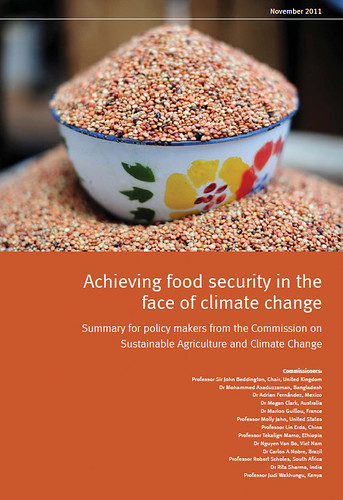Do you think that sustainable agriculture is as old as the origins of agriculture?

Image by ILRI
The Commission on Sustainable Agriculture and Climate Change is an initiative of the CGIAR Research Program on Climate Change, Agriculture and Food Security (CCAFS). The Commission is identifying which policy changes and actions are needed to help the world achieve food security in the face of climate change. The Commission launched this Summary for Policy Makers on 16 November 2011. (Photo on cover by Neil Palmer/CIAT.)
Question by : Do you think that sustainable agriculture is as old as the origins of agriculture?
Give your answer to this question below!

no, because in the neolithic age i really don’t think they were under the impression that anything would ever run out. this fact has only recently been discovered, actually
Trystyn
February 18, 2012 at 3:23 pm
The issues involved in feeding a few small isolated tribes are completely different to feeding a country of millions.
Any sustainability that early agriculture had was only by virtue of feeding a tiny population with unlimited land available. The idea of sustainability is a modern concept.
Chris Pitchr
February 18, 2012 at 4:13 pm
I agree with the other responders. The main reason so many of the ancient Middle East civilizations disappeared was because they let the soil erode away. Pull up the NRCS (Natural Resources Conservation Service) website and see if you can find the publication covering the rise and fall of civilizations though the ages. It covers research done decades ago concerning erosion, however I can’t remember the title of it. It’s no longer in print but is supposed to be on their website.
In the US during the 17th, 18th and 19th centuries people farmed their farm until the land was “worn out” and they then moved west, starting farming in a virgin area.
There are South American jungle tribes that still live like they did centuries ago and most of them practice slash and burn agriculture, clearing a site, farming it until it’s worn out and then going on to another area.
bikinkawboy
February 18, 2012 at 4:18 pm
In some ways and cultures…yes. The ancient Inca practiced a form of terraced farming and built vast networks of water tunnels to irrigate valleys and increase yields with little rainfall in the area and there is a form of soil called Terra Preta which was developed in the Amazon basin thousands of years ago which is far richer and productive than the native soils thus allowing for larger populations.
Ancient Egyptians calculated the flooding of the Nile every year and used that to their advantage…perhaps the greatest reason why they flourished.The Mayans are reported to have used aquaponics or floating boxed areas in the rivers or lakes they were confined to for a time to grow abundant crops to feed their populations. They were forced to do so because of neighboring tribes which fought with them over their existence.
Terra Preta soil…a possible solution to growing food demand and sequester carbon to reduce global warming
http://www.sciencedaily.com/releases/2008/04/080410153658.htm
http://deltafarmpress.com/management/terra-preta-unearthing-agricultural-goldmine
Inca culture……
“The Incan administrators had to travel great distances in order to ensure the stability of their empire. The Incas constructed nearly 12,000 miles of roads, most of which were paved with flat stones. Perfectly engineered bridges spanned rivers. Two roads, running the length of the empire, were built solely for use by the rulers. At two locations along the highlands road the Incans constructed huge administrative centers with more than 3,000 buildings.
The wheel was not used by the Incas, so administrators traveled on foot. Llamas carried cargo. Way stations along the route provided shelter. It was necessary to maintain a stable food supply along the route, so the Incas constructed a series of storehouses to fill this need. Some of these facilities could hold as much as a million bushels of grain. The Incas discovered they could use the natural fluctuations in temperature in the Andes to “freeze-dry” the stored food, thus preserving it for long periods.”
“Incan farming techniques were nothing short of amazing. The Incas worked with the forbidding terrain by creating terraced fields on mountainsides and by irrigating dry valleys. The chief crop was maize, but cotton, potatoes, an edible tuber called oca, and a grain called quinoa were also cultivated. ”
http://www.webspawner.com/users/luvnnangel/
Mayan agriculture…..
“Early Maya archaeologists had assumed that ancient Maya agriculture entailed little more than swidden cultivation. It turned out that they cultivated their fields as a community, planting seeds in holes made with a pointed wood stick in raised fields not only on river beds, but also in swamps and bajos (wetlands), they were clearly important Late Preclassic strategies that converted alleged “wastelands” into highly productive wetlands. Over the last few decades we have learned that the ancient Maya practiced strategies as diverse as terracing, drained fields, raised fields, canals, continuous cultivation involving crop rotation and household gardens, arboriculture, the use of the rapid growing white leadtree, Leucaena Leucocephala as forage, firewood and fertilizer, as well as other nitrogen sources, have been documented, all geared to the conditions of specific locales.”
http://www.authenticmaya.com/maya_agriculture.htm
paul h
February 18, 2012 at 4:20 pm